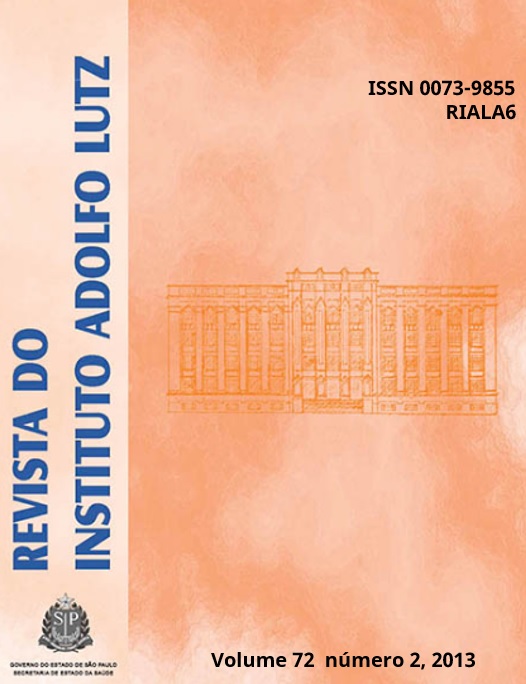Resumo
Staphylococcus aureus é um dos principais causadores de doenças de origem alimentar e, embora a Agência Nacional de Vigilância Sanitária – ANVISA não contemple especificamente a detecção de estafilococos coagulase-negativa (ECN) em alimentos, sabe-se que este grupo de bactérias apresenta genes responsáveis pela formação de biofilme e produção de enterotoxinas. No presente estudo foram identificados os S. aureus e ECN em amostras de salgados, e sua capacidade de produzir biofilme in vitro
foi avaliada por duas metodologias: ágar vermelho Congo e placa de microtitulação de poliestireno. Vinte e dois isolados de Staphylococcus pertencentes a oito diferentes espécies foram obtidos de 122 salgados, sanduíches e lanches. S. aureus, S. warneri e S. haemolyticus foram as espécies mais frequentemente isoladas. A produção de biofilme foi verificada em sete (31,8%) isolados pela técnica de ágar vermelho Congo e em três (13,6%) em placa de microtitulação. Nenhum isolado foi considerado positivo em ambas as metodologias. Apesar do baixo número de isolados, houve concordância de 59,1% entre os testes. A
capacidade de produzir biofilme é importante fator de virulência para Staphylococcus spp. e a detecção
destes isolados de amostras de alimentos pode ajudar a definir o papel dos ECN como agentes patogênicos
transmitidos por alimentos.
Referências
1. Miwa N, Kawamura A, Masuda T, Akiyama M. An outbreak of food poisoning due to egg yolk reaction-negative Staphylococcus aureus. Int J Food Microbiol. 2001;64:361-6.
2. Do Carmo LS, Dias RS, Linardi VR, Sena MJ, Santos A, Fari, ME et al. Food poisoning due to enterotoxigenic strains of Staphylococcus present in Minas cheese and raw milk in Brazil. Food Microbiol. 2002;19:9-14.
3. Do Carmo LS, Souza Dias R., Linardi VR, Sena MJ, Santos DA. An outbreak of staphylococcal food poisoning in the municipality of Passos, MG, Brazil. Braz Arch Biol Technol. 2003;46:581-6.
4. Colombari V, Mayer MD, Laicini ZM, Mamizuka E, Franco BD, Destro MT et al. Foodborne outbreak caused by Staphylococcus aureus: Phenotypic and genotypic characterization of strains of food and human sources. J Food Prot. 2007;70:489-93.
5. Baird-Parker AC. The staphylococci: an introduction. J Appl Microbiol. 1990;19:1-8.
6. Noble WC. Systematics and the natural history of Staphylococci. J Appl Microbiol. 1990;69:39-48.
7. Holtfreter S, Kolata J, Bröker BM. Towards the immune proteome of Staphylococcus aureus – The anti-S. aureus antibody response. Int J Food Microbiol. 2010;300:176-92.
8. Fey PD, Olson ME. Current concepts in biofilm formation of Staphylococcus epidermidis. Future Microbiol. 2010;5:917-33.
9. Jessen B, Lammert L. Biofilm and disinfection in meat processing plants. Int Biodeterior Biodegradation. 2003;51:265-9.
10. Somers EB, Wong AC. Efficacy of two cleaning and sanitizing combinations on Listeria monocytogenes biofilms formed at low temperature on a variety of materials in the presence of ready-to-eat-meat residue. J Food Prot. 2004;67:2218-29.
11. Harraghy N, Seiler S, Jacobs K, Hannig M, Menger MD, Herrmann M. Advances in in vitro and in vivo models for studying the staphylococcal factors involved in implant infections. Int J Artif Organs. 2006;29:368-78.
12. Melchior MB, Fink-Gremmels J, Gaastra W. Comparative assessment of the antimicrobial susceptibility of Staphylococcus aureus isolates from bovine mastitis in biofilm versus planktonic culture. J Vet Med B Infect Dis Vet Public Health. 2006a;53:326-32.
13. Melchior MB, Vaarkamp H, Fink-Gremmels J. Biofilms: a role in recurrent mastitis infection? Vet J. 2006b;171:398-407.
14. Clutterbuck AL, Woods EJ, Knottenbelt DC, Clegg PD, Percival SL. Biofilms and their relevance to veterinary medicine. Vet Microbiol. 2007;121:1-17.
15. Ezekiel CN, Kayode FO, Fapohunda SO, Olorunfemi MF, Kponi BT. Aflatoxigenic moulds and aflatoxins in street-vended snacks in Lagos, Nigeria. J Food Saf. 2012;14:83-8.
16. Hanashiro A, Morita M, Matté GR, Matté MH, Torres EAFS. Microbiological quality of selected street foods from a restricted area of São Paulo city, Brazil. Food Control. 2005;16:439-44.
17. Lancette GA, Bennett RW. Staphylococcus aureus and Staphylococcal Enterotoxins. In: Downes FP, Ito K. Compendium of Methods for the Microbiological Examination of Foods. Washington (DC):Apha, 2001 p.387-403.
18. Murray PR, Jorgensen JH, Baron EJ, Landry ML, Pfaller MA. Manual of Clinical Microbiology. 9th ed. Washington (DC): ASM Press; 2007.
19. Freeman DJ, Falkiner FR, Keane CT. New method for detecting slime production by coagulase negative staphylococci. J Clin Pathol. 1989;42:872-4.
20. Vasudevan P, Nair MKM, Annamalai T, Venkitanarayanan KS. Phenotypic and genotypic characterization of bovine mastitis isolates of Staphylococcus aureus for biofilm formation. Vet Microbiol. 2003;92:179-85.
21. Tavakoli HR, Soltani M, Bahonar A. Isolation of some human pathogens from fresh and smoked shad (Alosa kessleri) and silver carp (Hypophthalmichthys molitrix). Iran J Fish Sci. 2012;11:424-9.
22. Rode TM, Langsrud S, Holck A., Møretrø, T. Different patterns of biofilm formation in Staphylococcus aureus under food-related stress conditions. Int. J. Food Microbiol. 2007;116:372-383.
23. Feglo P, Sakyi K. Bacterial contamination of street vending food in Kumasi, Ghana. J Med Biomed Sci. 2012;1:1-8.
24. Pérez-Rodríguez F, Valero A, Carrasco E, García RM, Zurera G. Understanding and modelling bacterial transfer to foods: a review. Trends Food Sci Technol. 2008;19:130-43.
25. Podkowik M, Jarosław B, Bania J. Genotypes, antibiotic resis-tance, and virulence factors of staphylococci from ready-to-eat food. Foodborne Pathog Dis. 2012;9:91-9.
26. Møretrø T, Hermansen L, Holck AL, Sidhu MS, Rudi K, Langsrud S. Biofilm formation and the presence of the intercellular adhesion locus ica among staphylococci from food and food processing environments. Appl Environ Microbiol. 2003;69:5648-55.
27. Rodrigues LB, Santos LR, Tagliari VZ, Rizzo NN, Trenhago G, Oliveira AP et al. Quantification of biofilm production on polystyrene by Listeria, Escherichia coli and Staphylococcus aureus isolated from a poultry slaughterhouse. Braz J Microbiol. 2010;41:1082-5.

Este trabalho está licenciado sob uma licença Creative Commons Attribution 4.0 International License.
Copyright (c) 2012 Sarah Hwa In Lee, Carlos Henrique Camargo, Elisângela de Souza Miranda, Ary Fernandes Júnior, Vera Lúcia Mores Rall
